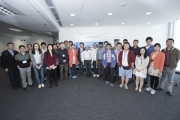Overview
Understanding the brain is one of the greatest challenges of this century. In the past few decades, there were great advances in probing the neural systems. Multielectrode arrays collect neural signals, in vivo or in vitro, enabling neural data to be processed and measured. Electroencephalography (EEG) records electrical activities of the brain, and further facilitates progress in brain-computer interface research. Optogenetics uses light to control neurons which have been genetically sensitized to light, providing powerful tools to map neural circuits. Functional magnetic resonance imaging (fMRI) enables scientists to map out the connections between different brain regions.
Theoretical models of the neural system have also gone a long way from the Hopfield model in the eighties. Updated models now incorporate complexity in network topology, such as the scale-free degree distribution and the hierarchical modular structure. Continuous attractor neural networks are introduced to deal with the processing of continuous information. Models now include neuronal mechanisms such as spike timing-dependent plasticity, balancing of excitation and inhibition, transmission delays, short-term synaptic depression, and spike-frequency adaptation.
In the last decade or so, we have seen rising impact of computational neuroscience in the domain of embodied artificial intelligence -- ranging from autonomous robotic systems, prosthetics and exoskeletons. A deep understanding of the computational principles in the human motor, neural and cognitive systems are not only beneficial but essential to successfully transferring the tremendous advances in robotics to bear fruits in the domain of human machine interfaces and assisted living technologies.
The importance of these exciting developments is further illustrated by the launching of two research projects: the 10-year flagship Human Brain Project in Europe and the BRAIN Initiative in the United States.
This focused program was proposed with the purpose of exploring the application of computational neuroscience to address issues in artificial intelligence (AI), and vice versa. For example, mechanisms of compensating transmission delays in the brain are relevant to the processing of dynamical information in AI, and mechanisms of transforming external information from the body-centered frame to the world-centered frame is relevant to navigation in robotics. Conversely, studies on how deficiencies in AI affect the performance can also shed light on neural disorders such as the Alzheimer Disease.
The program will bring together a number of prominent researchers in Statistics, Computer Science, and
Applied Mathematics with interests in big data to share their research findings, to exchange ideas, and to
encourage interactions and collaborations amongst participants.

Organizers, speakers and participants gather for a group
photo
Please click
HERE for more photos.
Co-sponsor
|


